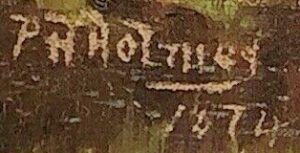Philip Henry Holmes was born in Gardiner, ME on April 23, 1845, the son of Philip C. and Sarah A. Holmes. Philip C. operated a machine shop and foundry in Gardiner where Philip H. kept his studio. The younger Holmes was interested in art and in his teens around 1861 he met Frederick A. Butman, also of Gardiner, who advised him to go to Boston and become a pupil of Samuel Lancaster Gerry. He studied under Gerry for one winter and the next summer set out to Jefferson, NH where he did a large landscape painting. He then went on to Shelburne, NH and met William Louis Sonntag who took him on as a student. They traveled and painted together for several years. Holmes also painted in the Mount Desert, Old Orchard, Southport and Gardiner areas of Maine. He began selling his landscape paintings in 1868.
In 1872 he had a canvas hung on the line of honor at the National Academy of Design in NY. In 1876 his 10 foot by 20 foot painting The Adirondacks from St. Albans, Vermont was exhibited at the Centennial Exhibition in Philadelphia where it remained on permanent exhibit until 1882. Later in his career his technique evolved from using a brush into exclusively using a palette knife. His later works had titles of: View from Jefferson, N.H., Mountain Mist, Mountain Lake Morning, Autumn, View at Southport, ME”, and a number of paintings of the Old Orchard area in Maine, one dated 1898. In 1900 his works were on sale in his studio but were to be sent to art stores in NY, Philadelphia, and Boston – including Williams and Everett of Boston. Holmes’s paintings are rare. Only one has appeared in 28 years of Barridoff Gallery auctions in Maine.
Around 1874 he became more involved in his father’s business and took it over but remained active as an artist into the early 1880s. He was multi-talented and a well-known business man and traveled in scientific circles throughout the world having won numerous scientific awards and acquired numerous patents for inventions including a water wheel, dry fibre pulp machine, self-lubricating graphite boxes for all kinds of machinery, graphite brushes for electric dynamos, a developing cabinet for developing photographs in the full glare of the noonday sun without the use of a dark closet, drawing rolls for cotton mills, mailing sheet, letter files, sash lock, water faucet, and an Egyptian ink well. He developed pedryoid (a rubberized type coating for cloth used for many products), and he would do paintings on the pedryoid material which he thought was superior to canvas. He also designed and built his own violins (one of which is now in the collection of the Metropolitan Museum of Art in NYC) as well as acquire a prized collection of expensive old violins, including a 1780 Guarnerius which was valued at $10,000 back in 1900.
Signatures
- 1869
- 1874
References
The Gardiner Independent, Gardiner, ME, Sat. February 24, 1900; Vol. 5, No. 49, Page 1: published by Wm. J. Landers.
Maine Antique Digest, February 2006, Shettleworth, Earle G. Jr. State Historian, Augusta, ME.

